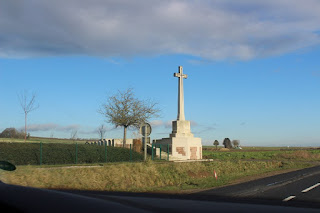Day 12 – In his
footsteps
In July 1916
my grandfather Cuthbert Douglas Adamson arrived back in Amiens with his mates
in the 17th Bttn AIF after a stint on the lines in Belgium, en-route
to the front. Over a 5 day period these
young men marched from Amiens via 5 little French towns to take part in a
battle whose name is etched in the minds of every Australian student of WW1
history – Pozieres. Today we followed
that route.
We picked up
our rental car (a very smart new VW Golf with all the bells and whistles including
sta-nav, Tony figured out what buttons to press to make it go and I figured out
how to drive the sat-nav, and off we went.
First stop
was a tiny little town tucked away on the banks of the Somme River called Argoeuvres. Picture postcard pretty and at 9.30am still
covered in frost. We left the car and wandered
down what looked like the main street. I
stopped in front of a building that had a string of flags across its driveway
having noticed the Aussie flag and a little man from across the street called
out Bonjour. Now I knew it was polite to
respond but I dreaded finding out he spoke as much English as I spoke
French. He called his wife who came to
our collective rescue. I explained why
we were in town and soon two friends came to join the one-sided conversation. Once I mentioned ‘Australian’ they became
even more interested in our little visit and at that point another man arrived,
said good morning to the locals and shook my hand – I was then introduced to
the Mayor of Argoeuvres! We chatted for
a few minutes and we all went our separate ways with them wishing me quite an
emotional ‘good luck with your visit’ It
was genuinely lovely.
Back in the
car, sat-nav re-programmed for our next stop Carronnette and we were on our
way.
Cardonnette
is another farming town, we stopped briefly but it wasn’t as pretty as our first
stop so back in the car and off we went to Rubempre
This part of
France is farming land, gently rolling land, and even in its winter state still
quite green, and everywhere you go, you pass little WW1 cemeteries
Stop four
was Warloy-Baillon
And then to
Albert. A much bigger town, Albert was
occupied by the Germans for part of August and September 1914 and following
this, re-taken by the Allies and subsequently the subject of many artillery barrages. The Gold Statue atop the church was hit by
artillery on January 15th 1915 and tipped forward till she was
hanging over the square – giving rise to the nickname ‘The Leaning Virgin’ The Brits took over the sector in July 1915
and Albert became an important supply depot.
Back in the
13th century a set of underground tunnels were dug under Albert and
in 1938 a major reconstruction took place and they were turned into air-raid
shelters. After WW2 they fell into disrepair until 1991 when some of the
tunnels were renovated and given over to a museum dedicated to the Battle of
the Somme. The museum opened in 1992 and
houses a relatively small collection of WW1 memorabilia.
After a late
lunch it was on to Pozieres. Driving
through almost pan-flat countryside it was difficult to imagine how either side
got any ‘cover’ from the relentless artillery barrages. The Australian Memorial is situated on the
site of the AIF 1st Division’s first major action in France – at a
cost of 5,200 casualties. Nearby are the
remnants of the Gibraltar blockhouse.
Not far from
the Australian Memorial is the ‘Windmill Site’ memorial on a ridge described as
being ‘more densely sewn with Australian sacrifice than any other place on
earth.’ Between July 23rd and
September 5th 1916 Australia suffered 23,000 casualties of whom more
than 6,700 were killed.
Just behind
the Windmill Site is a brand new memorial – and the one that brought me to
tears. Dedicated only 5 months ago is
the WW1 Animal War Memorial.
And nearby
the beginnings of what will be the Pozieres Memorial Park – a memorial to the 7000
Aussie diggers killed in the Battle of Pozieres, 4100 of whom have no known
grave. It’s currently a field of tiny
crosses, laid out in the shape of the Australian Rising Sun slouch hat badge
with the two main arms pointing to Thiepval and Mouquet Farm.
Last stop
for the day was the massive Memorial to the Missing at Thiepval. Designed by Sir Edwin Lutyens it is the
largest Commonwealth War Memorial in the world and lists the names of more than
72,000 soldiers whose graves are ‘Known only to God’ In the small cemetery behind the memorial 300
French, 300 English and a couple of Aussies are buried. Very few have a name on
their headstone.
It was
getting on for 4pm, the sun was going down and the temperature was plunging so
we headed back to Amiens – found our way to our reserved parking under the
aparthotel complex and went in search of coffee and cake.
Tomorrow we’re
heading north, the Arras, Vimy and the Couin Cemetery where my Kiwi grandfathers
uncle is buried. Hope the weather is a
repeat of what we got today.




































Wow! Thank you for this 'personal' family and general history lesson!
ReplyDelete